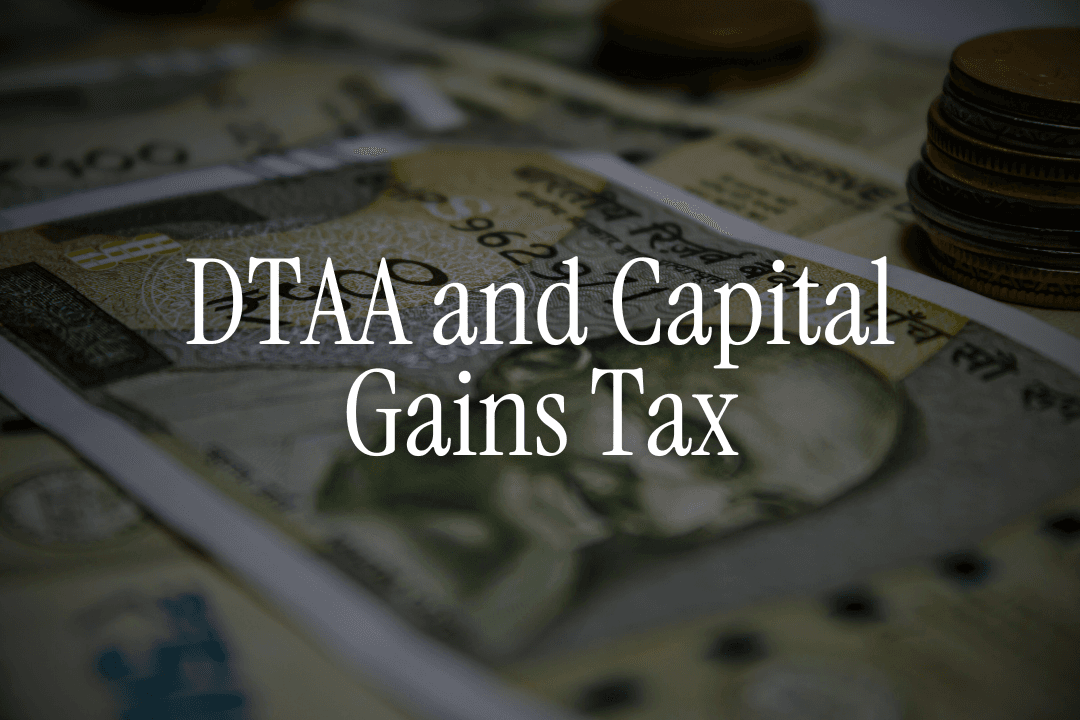
Radhika sold her Mumbai apartment after 5 years. The capital gains: ₹14 lakh.
In India, she paid 20% tax (₹2.8 lakh). But here's the twist - she's tax resident in Canada, where she also had to report this gain.
"Will I pay tax twice on the same gain?" she asked me during our consultation call.
Her CA in Mumbai said: "DTAA will help." Her accountant in Toronto said: "It's complicated."
Both were right. DTAA and capital gains is where theory meets messy reality.
What DTAA Capital Gains Actually Means
Here's the core truth: Every contracting state may tax capital gains as per the applicable domestic law with an exception to shipping and air transport companies. In other words, generally, capital gains are subject to tax based on the domestic laws of the country.
This means if you're a US resident selling Indian property, the property is liable to tax as per Indian domestic laws first. Then you deal with US tax implications.
The DTAA doesn't eliminate capital gains tax - it prevents you from paying the same tax twice.
Most NRIs think DTAA gives them special capital gains rates. Wrong. DTAA primarily helps you claim credit for taxes already paid.
👉 Tip: Capital gains articles in most DTAAs are short because countries prefer to tax gainswhere assets are located (source-based taxation).
How It Works for NRIs
Debt vs. Equity Capital Gains: The Critical Difference
Equity investments (shares, equity mutual funds):
- Short-term (under 12 months): 15% tax + 15% TDS
- Long-term (over 12 months):12.5% on gains above ₹1.25 lakh + 10% TDS Debt investments (debt funds, bonds, FDs):
- All gains treated as short-term from April 1, 2023
- Taxed at slab rates (up to 30%) + 30% TDS for NRIs
Real estate:
- Short-term (under 24 months): Slab rates + 30% TDS
- Long-term (over 24 months): 20% with indexation + 20% TDS
The tax rates for capital gains for NRIs are contingent on the asset type and the duration of holding.
👉 Tip: The biggest confusion? NRIs think debt and equity have the same DTAA treatment. They don't. Equity gets better rates everywhere.
How Different Countries Treat Your Indian Capital Gains
United States:
- Recognizes Indian tax paid through foreign tax credit
- You pay US capital gains tax (0%, 15%, or 20%) but get credit for Indian tax paid
- Net effect: You typically pay the higher of the two rates
Canada:
- Only 50% of capital gains are taxable
- Full credit for Indian taxes paid
- Often results in no additional Canadian tax
UAE:
- Zero capital gains tax for individuals
- Indian tax becomes your final tax
- Perfect jurisdiction for capital gains planning
UK:
- Capital gains tax ranges from 10% to 28%
- Credit for Indian tax paid
- May result in additional UK tax depending on gain size
Australia:
- Capital gains tax integrated with income tax
- Discount method available for long-term gains
- Credit for Indian taxes reduces Australian tax
👉 Tip: UAE residents have the best deal - pay only Indian rates with zero additional tax in UAE.
Key Advantages for NRIs
Foreign tax credit mechanism: Individuals who qualify as Indian residents, can claim credit in India for foreign taxes paid in the source country by filing Form 67 with the income tax department. For NRIs, the same principle applies but in your country of residence.
You claim a credit for the taxes paid in India when you file your tax return in your home country, as per its domestic laws and the DTAA.
No double taxation: You never pay full tax in both countries on the same gain.
Planning opportunities: You can time sales and choose residence strategically.
Lower overall rates: Often, the combined effect is lower than paying domestic rates in high-tax countries.
Investment flexibility: DTAA gives you confidence to invest across borders.
Here's a real calculation:
- Indian property gain: ₹10 lakh
- Indian tax (20%): ₹2 lakh
- US tax before credit (20%): ₹2 lakh
- US tax after Indian credit: ₹0
- Total tax paid: ₹2 lakh instead of ₹4 lakh
What to Watch Out For
Documentation nightmare: To avail the benefits of DTAA, NRIs must procure a Tax Residency Certificate from their country of residence and furnish it to the Indian tax authorities.
Currency conversion headaches: Gains must be calculated in Indian rupees, then converted back for foreign filing.
Timing mismatches: Financial years differ across countries. India's April-March doesn't match US January-December.
Indexation confusion: Some countries allow inflation adjustment, others don't. India allows it for property but not equity.
Different asset classifications: What's a capital asset in India might be ordinary income elsewhere.
DTAA treaty shopping: Changing residence just for tax benefits can trigger anti-avoidance rules.
👉 Tip: The biggest mistake? Not keeping detailed records in both currencies from day one of investment.
Smart Planning Strategies
Strategy 1: Residence Timing
The Play: Move to UAE before selling Indian assets.
The Benefit: Pay only Indian tax rates with zero UAE tax.
The Catch: Must establish genuine residence, not just tax residence.
Strategy 2: Asset Type Selection
The Play: Favor equity over debt for long-term investments.
The Benefit: 10% vs 30% tax rates, better DTAA treatment.
The Catch: Higher volatility and different risk profile.
Strategy 3: Holding Period Optimization
The Play: Hold assets beyond long-term thresholds.
The Benefit: Lower tax rates and better DTAA treatment.
The Catch: Market risk during extended holding periods.
Strategy 4: Gift City Alternative
The Play: Invest in GIFT City USD products instead of regular Indian assets.
The Benefit: Tax-free returns eliminate DTAA complexity entirely.
The Catch: Limited product options currently available.
👉 Tip: Our GIFT City USD FDs give 5.0% tax-free returns - no DTAA paperwork needed.
Strategy 5: Loss Harvesting
The Play: Book losses in high-tax years, gains in low-tax years.
The Benefit: Optimize overall tax burden across countries.
The Catch: Requires active portfolio management.
Strategy 6: Use the Special NRI Tax Regime (Chapter XII-A)
The Play: A powerful, often-overlooked option is the Special Tax Regime for NRIs under Chapter XII-A (Sections 115C-115I).
This allows you to elect for a simplified tax calculation on your "foreign exchange assets" (like Indian shares you bought with foreign currency).
The Benefit: You pay a flat 12.5% tax on Long-Term Capital Gains without the complexity of indexation.
More importantly, it offers a unique reinvestment exemption under Section 115F, allowing you to defer tax by reinvesting the sale proceeds into other specified assets within six months.
The Catch: This is an election. By choosing this simplified regime for an asset, you give up the right to claim indexation benefits or other deductions against that income.
You must run the numbers to see if this optional regime or the general tax law is more beneficial for your specific situation.
Application Process: Your Action Plan
Phase 1: Before Investment
Step 1: Understand tax implications in both countries
Step 2: Get tax residency certificate from your resident country
Step 3: Set up proper documentation systems
Step 4: Choose optimal investment structure
Phase 2: During Holding
Step 5: Monitor holding periods for tax optimization
Step 6: Keep detailed purchase and improvement records
Step 7: Track currency exchange rates for conversion
Phase 3: At Sale
Step 8: Calculate gains as per Indian rules
Step 9: File Indian returns and pay tax
Step 10: Claim foreign tax credit in resident country
Step 11: Submit DTAA documentation
Phase 4: Follow-up
Step 12: Ensure proper credit claim in foreign country
Step 13: Keep records for future audit requirements
Step 14: Plan for next investment cycle
👉 Tip: Start the foreign tax credit process immediately after Indian tax payment - don't wait until foreign filing deadline.
Conclusion
Capital gains and DTAA create complexity, but also opportunities. The key is understanding how your resident country treats Indian capital gains and planning accordingly.
Radhika's story? She claimed full credit for Indian tax in Canada and paid zero additional tax. But it took 8 months and ₹25,000 in professional fees.
Smart NRIs are choosing simpler alternatives. Our GIFT City USD FDs offer:
- Tax-free returns (no Indian tax)
- No DTAA paperwork
- Easy repatriation
- Currency protection
Sometimes the best tax strategy is avoiding the tax maze altogether.
Your next steps:
- Calculate potential DTAA benefits for your current holdings
- Consider relocating gains-heavy assets to tax-efficient structures
- Explore tax-free alternatives like GIFT City products
The confusion ends when you have the right strategy.
Download Belong App to explore tax-free USD FDs that eliminate capital gains complexity.
Disclaimer: Capital gains tax and DTAA rules are complex and vary by country and individual circumstances. Always consult qualified tax professionals in both countries before making investment decisions.




